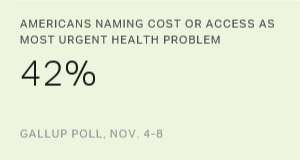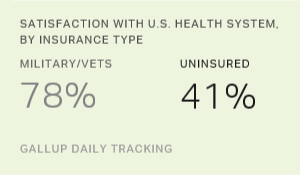Story Highlights
- Americans' views of cost and quality of their healthcare little changed
- Ratings are positive for majority of Americans
- Overall, little apparent impact of ACA on these attitudes
PRINCETON, N.J. -- Americans' overall satisfaction with the total cost they pay for their healthcare has been generally stable over the past 14 years. The 57% who now say they are satisfied is close to the 58% average across the 15 times Â鶹´«Ã½AV has asked the question since 2001. In November 2001, satisfaction hit a high of 64%, partly reflecting the rally effect after 9/11. The low point was 54% in 2006.

Americans cite cost as the facing the U.S. today. One might expect that their satisfaction with healthcare costs would drop after the Affordable Care Act (ACA) brought more previously uninsured people into the system and made changes to coverage. However, satisfaction with healthcare costs has remained relatively stable. The current 57% who are satisfied is lower than the 62% measured in November 2009 -- the year before the ACA was signed into law.
These data are from Â鶹´«Ã½AV's annual Health and Healthcare survey conducted Nov. 4-8. Subsequent stories will look at trends in Americans' views of the U.S. healthcare system more broadly and attitudes about the appropriate government role in the nation's healthcare system.
Not surprisingly, Americans who get their insurance through a government program such as Medicare or Medicaid are more satisfied with the cost of their insurance than are those who have private insurance. Previous Â鶹´«Ã½AV research has shown that those with government plans are also more likely than those with private plans to be satisfied with .

The has increased by more than five percentage points in the past several years, likely as a result of the ACA, but there has been no positive uptick in Americans' ratings of their healthcare coverage. About two-thirds of Americans rate their coverage as excellent or good, and relatively few -- 10% in the latest survey -- rate it as poor. One slight change is a drop from 30% in 2013 to 25% this year in the percentage of Americans who rate their coverage as excellent, and a simultaneous five-point increase to 22% in those who rate it as "only fair."
There is little difference in these healthcare coverage ratings among those with government and private insurance.

Americans have become somewhat less likely to rate the quality of healthcare they receive as excellent and more likely to rate it as good compared with two years ago. Excellent ratings dropped from 39% to 31%, while good ratings are up five points to 45%. The gap between good and excellent ratings has returned to where it was between 2001 and 2008, which represents a shift from the more evenly matched good and excellent ratings observed over the past five years. Despite this shift, the percentage in the combined excellent/good group is down only three points. Smaller percentages rate their healthcare quality as only fair or poor, broadly similar to previous years.

Bottom Line
The ACA was passed into law in March 2010, and many of its provisions have taken effect in the years since. These include the requirement that individuals must have health insurance or pay a fine, and the rollout of the state and federal exchanges from which Americans can purchase their insurance. Other provisions have mandated that all healthcare policies include certain types of coverage, that coverage cannot be denied because of pre-existing conditions and that young Americans are allowed to be covered under their parents' policies until age 26.
While the individual mandate portion of the ACA has clearly had an impact on lowering the percentage of Americans who are uninsured, Americans' attitudes about their healthcare coverage, its cost and the quality of healthcare they receive have changed little since the law went into effect. Much of this could reflect the reality that the ACA was not intended to change healthcare for the majority of Americans who already had healthcare coverage. But if the legislation did improve the situation for smaller percentages of the public who didn't previously have coverage or who had inadequate policies, it's not evident in these data.
From an overall perspective, the results show that more than two-thirds of Americans continue to rate their healthcare coverage and the quality of their healthcare as excellent or good. These are positive results, although their interpretation in the end depends on expectations. Some might argue that positive ratings should optimally reach closer to 100%, although Americans' health and economic situations are so different, and the healthcare system is so complex, that substantially increasing positive ratings may be a goal that is difficult to achieve.
Fewer than six in 10 Americans are satisfied with the cost of their healthcare, a category that subsumes coverage costs per se, as well as deductibles and copays. This level of satisfaction has remained fairly constant over the past 14 years, suggesting that it is a needle that is hard to move, short of an even more radical restructuring of the overall system than has occurred with the ACA.
Historical data are available in .
Survey Methods
Results for this Â鶹´«Ã½AV poll are based on telephone interviews conducted Nov. 4-8, 2015, with a random sample of 1,021 adults, aged 18 and older, living in all 50 U.S. states and the District of Columbia. For results based on the total sample of national adults, the margin of sampling error is ±4 percentage points at the 95% confidence level. All reported margins of sampling error include computed design effects for weighting.
Each sample of national adults includes a minimum quota of 60% cellphone respondents and 40% landline respondents, with additional minimum quotas by time zone within region. Landline and cellular telephone numbers are selected using random-digit-dial methods.
View complete question responses and trends.
Learn more about how works.


